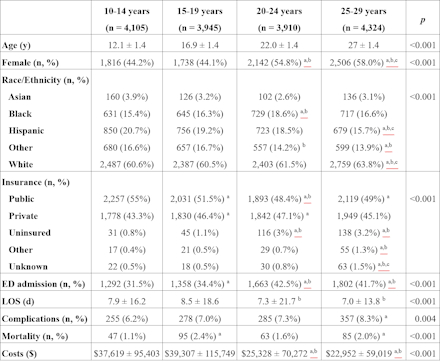Final ID: MDP167
Healthcare utilization trends for adolescents and young adults with moderate and severe congenital heart disease
Abstract Body (Do not enter title and authors here): Background
Improved congenital heart disease (CHD) care allows >90% of patients to live into adulthood, but young adult CHD patients are challenged by managing their own care as well as the risk of other comorbidities that may increase healthcare resource utilization. There is limited data on hospitalizations of adolescents with CHD, specifically during the transition from pediatric to adult care.
Hypothesis
We hypothesized that as adolescents age into adult care, utilization of healthcare resources will increase.
Methods
We conducted a retrospective review of the Vizient® Clinical Data Base (national, administrative database) for admissions from 10/2019-12/2023 aged 10-29 years with ICD-10 codes for moderate or severe CHD and stratified into age categories (10-14, 15-19, 20-24 and 25-29 years). Data included: demographics, hospital outcomes, insurance status, costs and admissions through the Emergency Department (ED). Comparisons were made using ANOVA for normally distributed data and χ2 for categorical data; Bonferroni test was used for post-hoc analysis. A p-value <0.05 was considered significant.
Results
There were 16,284 admissions during the study period; details in Table 1. With increasing age, there was an increase in female admissions, an increasing prevalence of Whites individuals and decreasing prevalence of Hispanic individuals. There was a decrease in public insurance and an increase in uninsured status and ED admissions with increasing age. Complications increased between 10-14 to 25-29 years old. Mortality rates had peaks at 15-19 years old and 25-29 years old. Despite increased ED visits, complications and mortality, costs decreased between the younger age groups and older age groups.
Conclusions
There is an increase in uninsured status and ED admissions for hospitalized young adults transitioning from pediatric to adult care. Despite this trend, overall hospital costs decrease, which may be due to more procedural admissions in children and adolescents. More studies are needed to help guide improvements in care during this at-risk time.
Improved congenital heart disease (CHD) care allows >90% of patients to live into adulthood, but young adult CHD patients are challenged by managing their own care as well as the risk of other comorbidities that may increase healthcare resource utilization. There is limited data on hospitalizations of adolescents with CHD, specifically during the transition from pediatric to adult care.
Hypothesis
We hypothesized that as adolescents age into adult care, utilization of healthcare resources will increase.
Methods
We conducted a retrospective review of the Vizient® Clinical Data Base (national, administrative database) for admissions from 10/2019-12/2023 aged 10-29 years with ICD-10 codes for moderate or severe CHD and stratified into age categories (10-14, 15-19, 20-24 and 25-29 years). Data included: demographics, hospital outcomes, insurance status, costs and admissions through the Emergency Department (ED). Comparisons were made using ANOVA for normally distributed data and χ2 for categorical data; Bonferroni test was used for post-hoc analysis. A p-value <0.05 was considered significant.
Results
There were 16,284 admissions during the study period; details in Table 1. With increasing age, there was an increase in female admissions, an increasing prevalence of Whites individuals and decreasing prevalence of Hispanic individuals. There was a decrease in public insurance and an increase in uninsured status and ED admissions with increasing age. Complications increased between 10-14 to 25-29 years old. Mortality rates had peaks at 15-19 years old and 25-29 years old. Despite increased ED visits, complications and mortality, costs decreased between the younger age groups and older age groups.
Conclusions
There is an increase in uninsured status and ED admissions for hospitalized young adults transitioning from pediatric to adult care. Despite this trend, overall hospital costs decrease, which may be due to more procedural admissions in children and adolescents. More studies are needed to help guide improvements in care during this at-risk time.
More abstracts on this topic:
A Machine Learning Algorithm to Detect Pediatric Supraventricular Tachycardia Risk from Baseline ECGs
Arezoumand Amirhossein, Danala Gopichandh, Masnadi Khiabani Parisa, Ebert David, Behere Shashank
Trends and Disparities in Stroke-Related Mortality among Heart Failure Patients in the United States, 1999-2020.Al-nusair Mohammed, Haider Waqas

